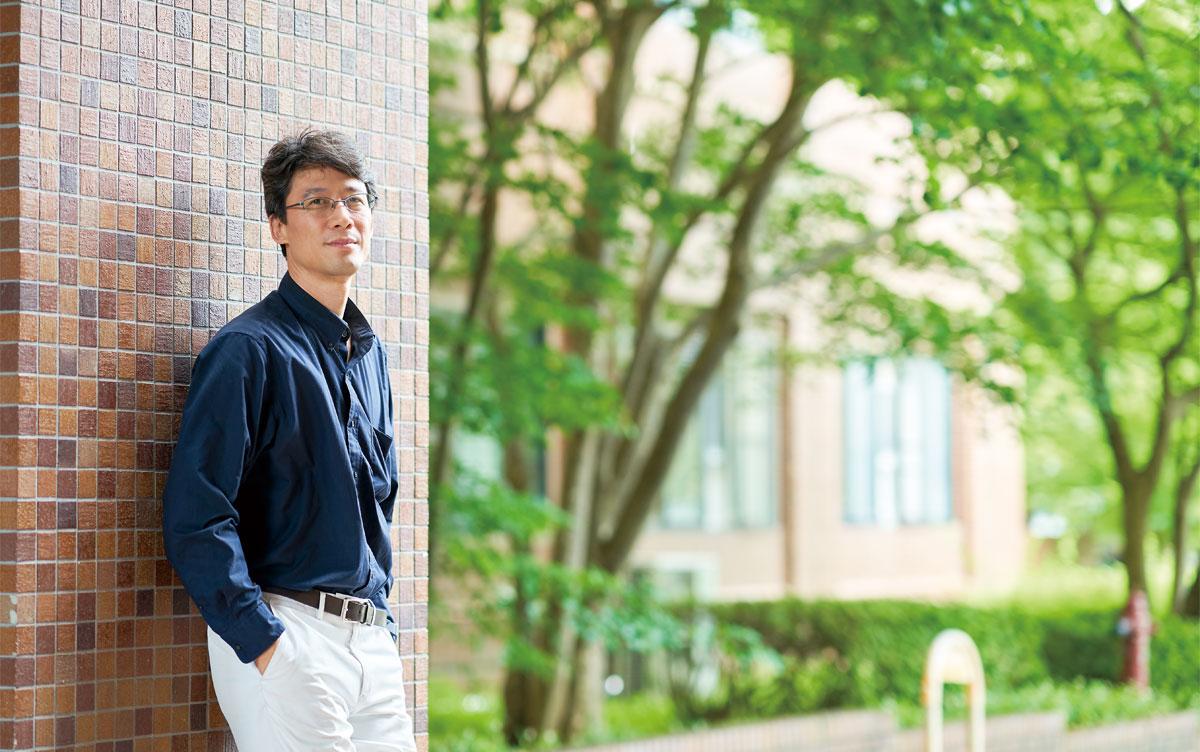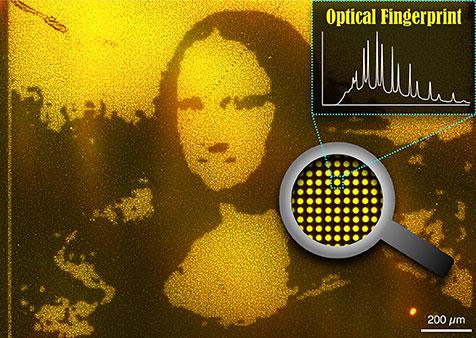TSUKUBA FRONTIER
#041 Assembling Molecules Revealed Emerging Novel Functionalities of Materials: Unique Characteristics by Creating Desired Shapes
Professor YAMAMOTO Yohei, Institute of Pure and Applied Sciences

The size of a single molecule is on the nanometer scale. Molecules must be assembled into larger aggregates to use them as conventional materials. Depending on the conditions, molecules can be assembled into various shapes, providing different functions depending on the shape. One of the unique shapes is sphere. Combining chemistry with physics and biology opens up the possibility of revealing micrometer-sized spheres.
Trapping light in a sphere

Painting of an optical memory created with microspheres
(Materials Horizons, 2020))
It may seem challenging to collect molecules to form a sphere, but in reality, it is not very difficult to shape them into a sphere via self-assembly. When a compound is dissolved in a solution, and a nonsolvent is slowly added, the molecules aggregate and precipitate. Some molecules form not only aspherical aggregates but also angular crystals.
When light is projected on a microsphere, we can observe luminescence inside the sphere. Light is reflected off the walls of the sphere and circulates within. In other words, light is trapped inside the sphere. This is known as "whispering gallery" phenomenon. It is named after the phenomenon observed when someone whispers inside a large circular dome, such as inside St. Paul's Cathedral, London, the sound wave from the whisper travels through the wall and is heard by people on the other side of the dome.
The same phenomenon occurs inside the microsphere. The light trapped inside the sphere resonates and emits a light with specific wavelength and sharp line width. This small light source can be used in devices such as optical memories and sensors. Since the color depends on the wavelength of the light, it is possible to extract signals of multiple colors; thus, making multiplexed communication possible.
Charm of Microscopic Materials
Since the early 2000s, there has been much focus on the development of materials with controlled molecular structures at the nanoscale; however, the slightly larger micrometer-scale materials have a different appeal. When working with molecular aggregates, the shape and arrangement of the molecules are important.
The advantage of micrometer-scale materials is that they can be observed reasonably well with an ordinary optical microscope. Electron microscopes are unsuitable for observing molecules whose assembling structures change by vacuum drying. Meanwhile, using an optical microscope, you can observe the state, shape, and luminescence of the materials easily. The easy observation of objects is also an important factor when conducting a research.
Interdisciplinary exchange with a smile
Our research on microspheres began by coincidence. While investigating the aggregate structure of conductive polymers, we obtained spheres and learned that spheres have unique properties. Furthermore, during joint research with a German physicist, we discovered the phenomenon of light resonance within the sphere. Discussions with other researchers in physics, a field that I had not explored much before, led to a new research theme: microspheres and light.
We examine many types of materials in our research, but not all of them can be synthesized by ourselves. I actively participate in academic conferences and exhibitions to constantly learn about new research results, and when I find a material that looks interesting, I approach the researcher who is working on it. I sometimes ask for help from other specialists in measuring the physical properties of materials. Approaching them with a smile usually helps me get their cooperation. Each researcher has a different research objective, so if we learn something new, it is mutually beneficial. This kind of interdisciplinary exchange within and beyond the university is a part of our research.
Beyond the light
Research does not always proceed smoothly, and we often encounter difficulties: we plant several "seeds" in the next five years or so, and if even one of them blossoms, the research project is a success. Sometimes we start from an idea or a fantasy, but communication with students also opens a treasure trove of ideas. It is stimulating to receive unexpected research reports.
Over the past decade, we have been vigorously researching optical applications using microspheres, but recently we began exploring developments other than optical devices using microspheres. One of them is related to the fields of biology and environmental science. If biodegradable natural polymers can be formed into spheres, they can be used for toiletries or medical applications. Since microbeads made of synthetic polymers leak into environment and cause problems, there is a great need to switch to natural materials, and this will be a promising contribution to the society. I am also interested in completely different fields such as marketing and management, and ten years from now, I may be taking on completely different challenges.
I want to do something that I have never done before—that is my main motivation.
Profile

2003 Doctor of Science from the Department of Chemistry, Graduate of Science, Osaka University.
2004-2010 Research Fellow of ERATO and SORST projects, Japan Science and Technology Agency.
November 2010 Associate Professor, University of Tsukuba
February 2018 Professor, University of Tsukuba
January 2022 Established "MyQtech Inc.," a venture company originating from the University of Tsukuba, aiming at the social implementation of the research conducted at the university.
His motto is to make research fun and exciting. However, his recent motto is "As a researcher, you should question everything."
(URL:https://www.ims.tsukuba.ac.jp/~yamamoto_lab/)
Article by Science Communicator at the Bureau of Public Relations
TSUKUBA FRONTIER (PDF for printing)


